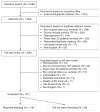Severe bleeding events in adults and children with primary immune thrombocytopenia: a systematic review
- PMID: 25495497
- PMCID: PMC4991942
- DOI: 10.1111/jth.12813
Severe bleeding events in adults and children with primary immune thrombocytopenia: a systematic review
Abstract
Background: The burden of severe bleeding in adults and children with immune thrombocytopenia (ITP) has not been established.
Objectives: To describe the frequency and severity of bleeding events in patients with ITP, and the methods used to measure bleeding in ITP studies.
Patients/methods: We performed a systematic review of all prospective ITP studies that enrolled 20 or more patients. Two reviewers searched Medline, Embase, CINAHL and the Cochrane registry up to May 2014. Overall weighted proportions were estimated using a random effects model. Measurement properties of bleeding assessment tools were evaluated.
Results: We identified 118 studies that reported bleeding (n = 10 908 patients). Weighted proportions for intracerebral hemorrhage (ICH) were 1.4% for adults (95% confidence interval [CI], 0.9-2.1%) and 0.4% for children (95% CI, 0.2-0.7%; P < 0.01), most of whom had chronic ITP. The weighted proportion for severe (non-ICH) bleeding was 9.6% for adults (95% CI, 4.1-17.1%) and 20.2% for children (95% CI, 10.0-32.9%; P < 0.01) with newly-diagnosed or chronic ITP. Methods of reporting and definitions of severe bleeding were highly variable in primary studies. Two bleeding assessment tools (Buchanan 2002 for children; Page 2007 for adults) demonstrated adequate inter-rater reliability and validity in independent assessments.
Conclusions: ICH was more common in adults and tended to occur during chronic ITP; other severe bleeds were more common in children and occurred at all stages of disease. Reporting of non-ICH bleeding was variable across studies. Further attention to ITP-specific bleeding measurement in clinical trials is needed to improve standardization of this important outcome for patients.
Keywords: bleeding; intracranial hemorrhages; outcome assessment health care; platelets; purpura, thrombocytopenic.
© 2014 International Society on Thrombosis and Haemostasis.
Conflict of interest statement
of Conflict of Interests D. M. Arnold reports grants from Amgen and Glaxo-SmithKline and honoraria from Amgen and Bristol Meyers Squibb outside of the submitted work. The other authors state that they have no conflict of interests.
Comment in
-
Severe bleeding events in adults and children with primary immune thrombocytopenia: a systematic review: comment.J Thromb Haemost. 2015 Aug;13(8):1521-2. doi: 10.1111/jth.12984. Epub 2015 Jun 16. J Thromb Haemost. 2015. PMID: 25903487 No abstract available.
-
Severe bleeding events in adults and children with primary immune thrombocytopenia: a systematic review: reply.J Thromb Haemost. 2015 Aug;13(8):1522-3. doi: 10.1111/jth.13019. Epub 2015 Jun 19. J Thromb Haemost. 2015. PMID: 26017732 No abstract available.
References
-
- Kuter DJ, Mathias SD, Rummel M, Mandanas R, Giagounidis AA, Wang X, Deuson RR. Health-related quality of life in non-splenectomized immune thrombocytopenia patients receiving romiplostim or medical standard of care. Am J Hematol. 2012;87:558–61. - PubMed
-
- McMillan R, Bussel JB, George JN, Lalla D, Nichol JL. Self-reported health-related quality of life in adults with chronic immune thrombocytopenic purpura. Am J Hematol. 2008;83:150–4. - PubMed
-
- Neunert CE, Buchanan GR, Blanchette V, Barnard D, Young NL, Curtis C, Klaassen RJ. Relationships among bleeding severity, health-related quality of life, and platelet count in children with immune thrombocytopenic purpura. Pediatr Blood Cancer. 2009;53:652–4. - PubMed
-
- Neunert CE, Buchanan GR, Imbach P, Bolton-Maggs PH, Bennett CM, Neufeld E, Vesely SK, Adix L, Blanchette VS, Kuhne T. Bleeding manifestations and management of children with persistent and chronic immune thrombocytopenia: data from the Intercontinental Cooperative ITP Study Group (ICIS) Blood. 2013;121:4457–62. - PubMed
Publication types
MeSH terms
Grants and funding
LinkOut - more resources
Full Text Sources
Other Literature Sources
Medical


